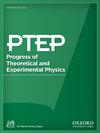K + N elastic scatterings for estimation of in-medium quark condensate with strange quarks
IF 8.3
4区 物理与天体物理
Q1 Physics and Astronomy
引用次数: 0
Abstract
We revisit the low-energy K+N elastic scatterings in the context of the in-medium quark condensate with strange quarks. The chiral ward identity connects the in-medium quark condensate to the soft limit value of the pseudoscalar correlation function evaluated in nuclear matter. The in-medium correlation function of the psuedoscalar fields with strangeness describes in-medium kaon propagation and is obtained by kaon-nucleon scattering amplitudes in the low density approximation. We construct the kaon-nucleon scattering amplitudes in chiral perturbation theory up to the next-to-leading order and add some terms of the next-to-next-to-leading order with the strange quark mass to improve expansion of the strange quark sector. We also consider the effect of a possible broad resonance state around Plab = 600 MeV/c for I = 0 reported in the previous study. The low energy constants are determined by existent K+N scattering data. We obtain good reproduction of the K+p scattering amplitude by chiral perturbation theory, while the description of the KN amplitude with I = 0 is not so satisfactory due to the lack of low energy data. Performing analytic continuation of the scattering amplitudes obtained by chiral perturbation theory to the soft limit, we estimate the in-medium strange quark condensate.用于估算带有奇异夸克的中间夸克凝聚态的 K + N 弹性散射
我们在带有奇异夸克的中间夸克凝聚态的背景下重新审视了低能 K+N 弹性散射。手性沃德特性将中量夸克凝聚态与核物质中评估的伪斯卡尔相关函数的软极限值联系起来。具有奇异性的伪斯卡拉场的介质内相关函数描述了介质内卡昂的传播,并通过低密度近似中的卡昂-核子散射振幅得到。我们在手性扰动理论中构建了直到次引阶的高子-核子散射振幅,并添加了一些次引阶的奇异夸克质量项,以改进奇异夸克部门的扩展。我们还考虑了先前研究中报告的 I = 0 时 Plab = 600 MeV/c 附近可能存在的宽共振态的影响。低能量常数由现有的 K+N 散射数据确定。我们通过手性扰动理论很好地再现了 K+p 散射振幅,而由于缺乏低能数据,对 I = 0 时 KN 振幅的描述并不令人满意。将手性扰动理论得到的散射振幅解析延续到软极限,我们估算出了中间奇异夸克凝聚态。
本文章由计算机程序翻译,如有差异,请以英文原文为准。
求助全文
约1分钟内获得全文
求助全文
来源期刊

Progress of Theoretical and Experimental Physics
PHYSICS, MULTIDISCIPLINARY-PHYSICS, PARTICLES & FIELDS
CiteScore
12.00
自引率
5.70%
发文量
148
审稿时长
17 weeks
期刊介绍:
Progress of Theoretical and Experimental Physics (PTEP) is an international journal that publishes articles on theoretical and experimental physics. PTEP is a fully open access, online-only journal published by the Physical Society of Japan.
PTEP is the successor to Progress of Theoretical Physics (PTP), which terminated in December 2012 and merged into PTEP in January 2013.
PTP was founded in 1946 by Hideki Yukawa, the first Japanese Nobel Laureate. PTEP, the successor journal to PTP, has a broader scope than that of PTP covering both theoretical and experimental physics.
PTEP mainly covers areas including particles and fields, nuclear physics, astrophysics and cosmology, beam physics and instrumentation, and general and mathematical physics.
 求助内容:
求助内容: 应助结果提醒方式:
应助结果提醒方式:


